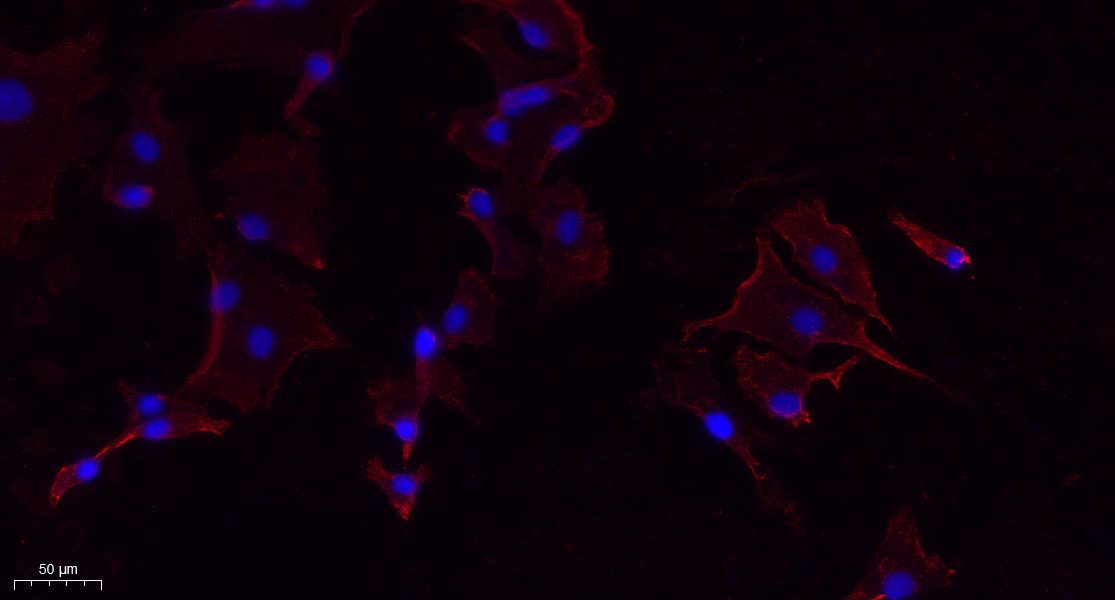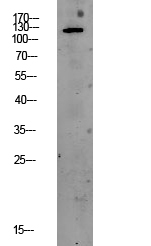PERK Monoclonal Antibody
- Catalog No.:YM0517
- Applications:WB;ELISA
- Reactivity:Human
- Target:
- PERK
- Fields:
- >>Mitophagy - animal;>>Autophagy - animal;>>Protein processing in endoplasmic reticulum;>>Apoptosis;>>Non-alcoholic fatty liver disease;>>Alzheimer disease;>>Parkinson disease;>>Amyotrophic lateral sclerosis;>>Prion disease;>>Pathways of neurodegeneration - multiple diseases;>>Hepatitis C;>>Measles;>>Herpes simplex virus 1 infection;>>Lipid and atherosclerosis
- Gene Name:
- EIF2AK3
- Protein Name:
- Eukaryotic translation initiation factor 2-alpha kinase 3
- Human Gene Id:
- 9451
- Human Swiss Prot No:
- Q9NZJ5
- Mouse Swiss Prot No:
- Q9Z2B5
- Immunogen:
- Purified recombinant fragment of human PERK expressed in E. Coli.
- Specificity:
- PERK Monoclonal Antibody detects endogenous levels of PERK protein.
- Formulation:
- Liquid in PBS containing 50% glycerol, 0.5% BSA and 0.02% sodium azide.
- Source:
- Monoclonal, Mouse
- Dilution:
- WB 1:500 - 1:2000. ELISA: 1:10000. Not yet tested in other applications.
- Purification:
- Affinity purification
- Storage Stability:
- -15°C to -25°C/1 year(Do not lower than -25°C)
- Other Name:
- EIF2AK3;PEK;PERK;Eukaryotic translation initiation factor 2-alpha kinase 3;PRKR-like endoplasmic reticulum kinase;Pancreatic eIF2-alpha kinase;HsPEK
- Molecular Weight(Da):
- 125kD
- References:
- 1. Autophagy. 2008 Apr 1;4(3):364-7.
2. J Biol Chem. 2008 Jun 20;283(25):17020-9.
3. Hum Mol Genet. 2008 Oct 15;17(20):3254-62.
- Background:
- The protein encoded by this gene phosphorylates the alpha subunit of eukaryotic translation-initiation factor 2, leading to its inactivation, and thus to a rapid reduction of translational initiation and repression of global protein synthesis. This protein is thought to modulate mitochondrial function. It is a type I membrane protein located in the endoplasmic reticulum (ER), where it is induced by ER stress caused by malfolded proteins. Mutations in this gene are associated with Wolcott-Rallison syndrome. [provided by RefSeq, Sep 2015],
- Function:
- catalytic activity:ATP + a protein = ADP + a phosphoprotein.,disease:Defects in EIF2AK3 are the cause of Wolcott-Rallison syndrome (WRS) [MIM:226980]; also known as multiple epiphyseal dysplasia with early-onset diabetes mellitus. WRS is a rare autosomal recessive disorder, characterized by permanent neonatal or early infancy insulin-dependent diabetes and, at a later age, epiphyseal dysplasia, osteoporosis, growth retardation and other multisystem manifestations, such as hepatic and renal dysfunctions, mental retardation and cardiovascular abnormalities.,domain:The lumenal domain senses perturbations in protein folding in the ER, probably through reversible interaction with HSPA5/BIP.,enzyme regulation:Perturbation in protein folding in the endoplasmic reticulum (ER) promotes reversible dissociation from HSPA5/BIP and oligomerization, resulting in transautophosphorylation and kinase act
- Subcellular Location:
- Endoplasmic reticulum membrane; Single-pass type I membrane protein.
- Expression:
- Ubiquitous. A high level expression is seen in secretory tissues.
Cheng, Jinbo, et al. "Vitamin D combined with resveratrol prevents cognitive decline in SAMP8 mice." Current Alzheimer Research 14.8 (2017): 820-833.
- June 19-2018
- WESTERN IMMUNOBLOTTING PROTOCOL
- June 19-2018
- IMMUNOHISTOCHEMISTRY-PARAFFIN PROTOCOL
- June 19-2018
- IMMUNOFLUORESCENCE PROTOCOL
- September 08-2020
- FLOW-CYTOMEYRT-PROTOCOL
- May 20-2022
- Cell-Based ELISA│解您多样本WB检测之困扰
- July 13-2018
- CELL-BASED-ELISA-PROTOCOL-FOR-ACETYL-PROTEIN
- July 13-2018
- CELL-BASED-ELISA-PROTOCOL-FOR-PHOSPHO-PROTEIN
- July 13-2018
- Antibody-FAQs
- Products Images

- Western Blot analysis using PERK Monoclonal Antibody against HEK293 (1) and EIF2AK3-hIgGFc transfected HEK293 (2) cell lysate.
.jpg)


